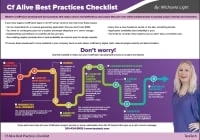Peter Ivanov talks about “Virtual Power Teams for ColdFusion Development (3 mistakes to avoid)” in this episode of the CF Alive Podcast, with host Michaela Light.
Contents
- Show notes
- Why virtual ColdFusion software teams?
- Common problems and mistakes with virtual teams
- Creating a successful virtual team
- How to hiring to your virtual team
- Onboarding new virtual team member
- WWIT for you to make CF more alive this year?
- Mentioned in this episode
- Listen to the Audio
- Bio
- Links
- Interview transcript
Show notes
Why virtual ColdFusion software teams?
-
- Experts are hard to find and may not want to relocate
- Offshoring and labor arbitrage
- Easier scaling of projects
- Fast delivery
- 81% of teams are virtual – Forrester Research
Common problems and mistakes with virtual teams
Neglecting the team’s personal life and personality
- Meet each team member and lifeline successes and struggles
- In person
- Zoom video call
- What makes their heart sing
Only have meetings for problems or if manager has need
- Regular meetings, not manager dominated, all people get a chance to speak
- personal update from each person (< 2 min max)
- Team decides the frequency of meetings
- Bottom-up agenda and goals → roadmap and milestones
- Formal project meetings and milestones → peer pressure to deliver
- Empower and regular reporting of progress
Managers take performance for granted
- Expect good/great performance without recognition or rewards
- Praise results and behavior. Not critic online – do one on one. Timely
Time zones
- Some people will need to comprise – but rotate to make it fair
- Split to two meetings with different times if big global teams
Culture
- Culture Map
- Democratic vs Autocratic styles
- Questioning directly or not
- Saving face
- Conflict style
- Decision-making style – top down or bottom up
Creating a successful virtual team
10 big rocks
- Personality and focus
- Member Strengths (public)
- Interdependent goals
- Knowledge management – and issue champions
- Regular Scheduled feedback (1-on-1)
- Recognition
- Diversity
- Winning spirit
- Next generation leaders
Virtual pizza
Reward trip
Virtual communication
- Zoom, email, basecamp/other PM tools, slack
- What purpose for each tool
- Email – good for updates
- Team charter – response time eg 24 hours
- Chat – Urgent message
- Team charter – response time eg 1-2 hours
- Slack – good for multiple projects and teams
- Trello – dynamic communication and sharing
- Or closed FB group
- Or MS-Office 365 Teams
- Baseline plan plus version control
- Zoom – more emotional or upset topics
- Images can help
- Recording videos to share with team
- Future – Virtual Reality teams and AI
How to hiring to your virtual team
- Balanced team – Meredith Belbin 9 roles in a team
- Can work on own, self-motivating
- Can meet social needs another way than work
- Don’t hire all the
Onboarding new virtual team member
WWIT for you to make CF more alive this year?
Mentioned in this episode
- His book Virtual Power Teams: How to Deliver Projects Faster, Reduce Cost and Develop your Organization for the Future
- Power Teams Beyond Borders
- Episode with Peter on using your intuition in virtual teams
- Book Erin Mayer The Culture Map
- Meredith Belbin 9 roles in a team
Listen to the Audio
Bio
Peter Ivanov
Peter Ivanov is Manager, Entrepreneur and Virtual teams Expert with over 20 years of international experience.
Born in Bulgaria he graduated Mathematics and joined a multinational company as Data Analyst. He quickly became IT Manager for Bulgaria and gradually worked his way up to IT Services Manager for Eastern Europe, Middle East and Africa. Peter recognized the growing importance of the teams in multiple locations and developed an innovative method for leading Virtual teams.
In 2007 the Team led by Peter won the “Best of the Best” award for outstanding Project management in establishing global Shared services.
In 2012 his Team won the “Global IT Connect Award” for excellent Engagement in a global cross-functional environment.
In 2013 Peter founded “Virtual Power Teams” and started new career as Keynote speaker and Executive coach on New Leadership.
Peter is a passionate athlete and World Senior Champion in Discus. He actively supports young Talents in the fields of mathematics and sports.
In his dynamic keynote speeches and master classes, held in English, German, Bulgarian and Russian, Peter uses the experience he has gained as Manager, Athlete, Entrepreneur and, yes, the father of five little girls, to show you how to build up and lead your own successful Virtual Teams.
As an expert in New Leadership Peter supports managers to retain the gravity of their Team despite the geographical distance, age and cultural differences, and deliver Top business performance!
Links
Interview transcript
Michaela: Welcome back to the show. I'm here with Peter Ivanov. Oops! Tangled your name up there Peter. And he is the author of ‘Virtual Path Teams’- How to live deliver projects faster, reduce costs and develop your organization for the future’. And we're gonna be talking about how you can have virtual teams be successful for your ColdFusion development. And three mistakes you want to avoid when you have virtual teams. So we'll also look at how to improve communication when you have a virtual team, and how to hire on to a virtual team successfully, and how to on board virtual team members. So welcome Peter.
Peter: Thank you Michael. It is an honor to be with your audience again. [Inaudible] [00:49] forward to you know [crosstalk] in the ColdFusion development.
Michaela: Yes, so and if you don't know Peter, he has lead IT teams with over 100 people spread over multiple countries and time zones. And the teams he's worked with have won multiple cooperate awards. So he knows a lot about the subject as well as having written a book on the topic, and he gives keynotes about this as well so. So, why have a virtual ColdFusion software team Peter?
Read more
And to continue learning how to make your ColdFusion apps more modern and alive, I encourage you to download our free ColdFusion Alive Best Practices Checklist.
Because… perhaps you are responsible for a mission-critical or revenue-generating CF application that you don’t trust 100%, where implementing new features is a painful ad-hoc process with slow turnaround even for simple requests.
What if you have no contingency plan for a sudden developer departure or a server outage? Perhaps every time a new freelancer works on your site, something breaks. Or your application availability, security, and reliability are poor.
And if you are depending on ColdFusion for your job, then you can’t afford to let your CF development methods die on the vine.
You’re making a high-stakes bet that everything is going to be OK using the same old app creation ways in that one language — forever.
All it would take is for your fellow CF developer to quit or for your CIO to decide to leave the (falsely) perceived sinking ship of CFML and you could lose everything—your project, your hard-won CF skills, and possibly even your job.
Luckily, there are a number of simple, logical steps you can take now to protect yourself from these obvious risks.
No Brainer ColdFusion Best Practices to Ensure You Thrive No Matter What Happens Next
ColdFusion Alive Best Practices Checklist
Modern ColdFusion development best practices that reduce stress, inefficiency, project lifecycle costs while simultaneously increasing project velocity and innovation.
√ Easily create a consistent server architecture across development, testing, and production
√ A modern test environment to prevent bugs from spreading
√ Automated continuous integration tools that work well with CF
√ A portable development environment baked into your codebase… for free!
Learn about these and many more strategies in our free ColdFusion Alive Best Practices Checklist.

